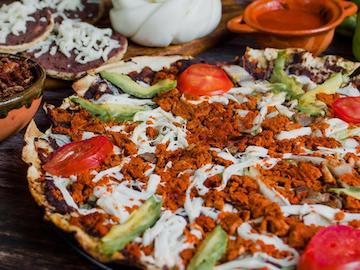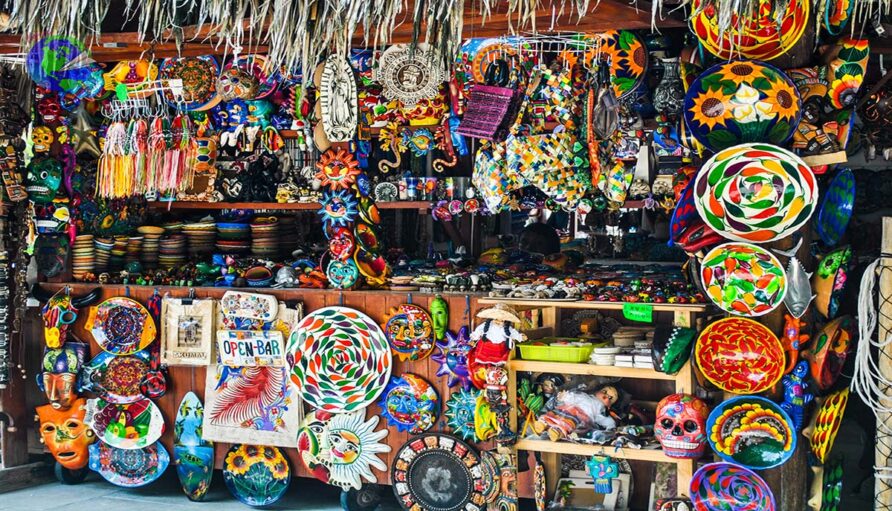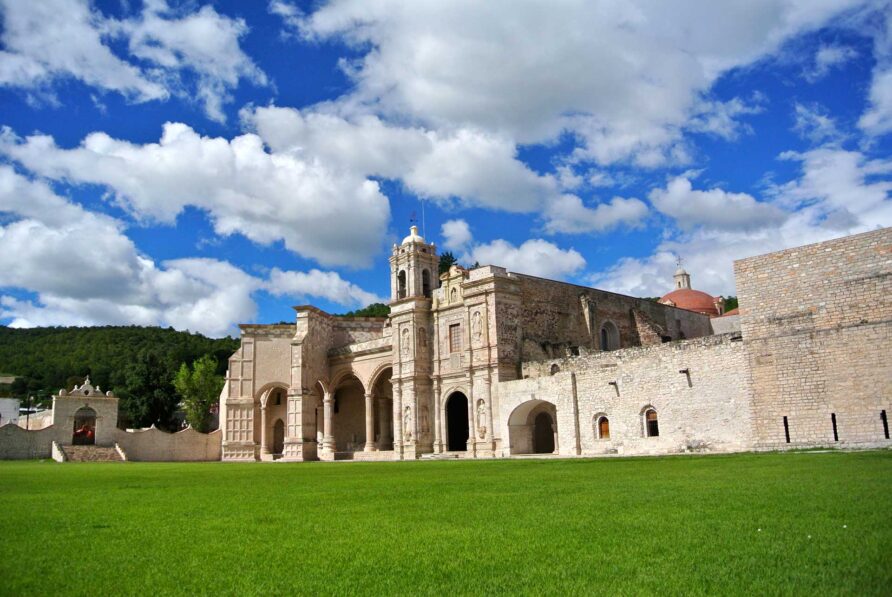Ro-House » Oaxaca » Gastronomy
The Oaxaca's culinary tradition it is extraordinary and very deeply rooted. There are fourteen different ethnic groups, with their own dishes.
It is an area of incomparable wealth for the tourist interested in gastronomy, ethnology and culture in general. Oaxaca is the land of mezcal, tlayudas, and the famous seven moles. You have to dedicate several days to it. Oaxacan gastronomy is one of the cultural manifestations that identify and define its people, due to its variety, richness and complexity that have been preserved through the centuries. The best way to enjoy Oaxacan food is by tasting it, from the “strong” dishes that are used to enjoying at lunchtime; like the traditional Oaxacan snacks that can be enjoyed at any time of the day.
In the process of preparing Oaxacan dishes, a series of ingredients are combined, starting with beef, pork, mutton, turkey, chicken or fish: up to the presence of chili peppers, tomatoes, aromatic herbs and spices.
The gastronomy of Oaxaca has a variety of moles of all flavors and colors, we find in Oaxacan lands from: Mole negro, Mole rojo, Mole coloradito, Mole almendrado, Mole chichilo, Mole amarillo, Oaxaca-style chicken livers, Tasajo, Mixtec pozole, Cecina, Cat broth, Chapulines, Tlayudas, Chickpea broth, Oaxacan sausages, Chepil rice, Caldillo de vigilia, Chiles stuffed with sardines, Serrano chili sauce, Chicatana ant sauce, Chepil tamales, Fish tamales from Isthmus, Chiles de agua stuffed with quesillo, Chiles pasilla stuffed with picadillo, among other culinary delights.
And all the variety of regional sweets, you can taste a rich burnt milk, fritters, tuna snow and burnt milk, Yema bread with chocolate.

Mezcal

The name of Mezcal It has its roots in one of the ancient native languages of the area and translates as 'agave (also known as maguey) cooked'. Although pre-Hispanic Oaxacans used maguey to make pulque (an undistilled alcoholic beverage), it seems that real advances in mezcal production occurred when the Spanish arrived in Oaxaca; by bringing with them their knowledge of distillation processes.
Mezcal is a rich, handcrafted flavored drink that requires considerable attention to be produced. Mezcal production today remains more or less as it was when the Spanish arrived hundreds of years ago. Each 'recipe' is transmitted from generation to generation within the families that care about its production; Because each family has its own approach to mezcal production, there are an enormous number of different flavors. It is also in this way that the rich diversity of flavors and traditions are preserved for all to enjoy.
Mezcal is normally served with white salt or worm salt (salt mixed with a cooked larva and ground chili), lemon or orange.
There are different types of maguey, and each produces a different version of mezcal; one of the best known, although it does not correspond exactly to the traditional definition of mezcal, is tequila. Simply put, tequila is actually a type of mezcal. The production of mezcal is regulated by the Official Mexican Standard NOM-070-SCFI-1994.

Tlayudas (Clayudas)

The Tlayuda, also known as Clayuda, is a typical corn tortilla from the state of Oaxaca, in Mexico. They won a poll organized by the series “Street food" from Netflix, since they were named the best street dish in Latin America, that's why we explain what they are.
The tlayudas are born in the Central Valley region of Oaxaca, the word comes from the Nahuatl "tlao-li", which means "shelled corn." According to the Larousse Encyclopedic Dictionary of Mexican Gastronomy, tlayuda is a large corn tortilla, measuring approximately 30 centimeters in diameter, it is made from white corn.
To cook it, first it is put on the comal and, later, it is placed on the coals where acquires a more toasted and brittle texture. The tlayudas, in addition to the crunchy omelette, gets readyn with a delicious combination of ingredients. Although there are currently various preparations, but the traditional tlayudas They are prepared with a layer of beans, jerky (dried meat enchilada), chorizo, quesillo, jerky, and of course, your sauce to taste.
The tlayuda in most regions of Oaxaca, when served is accompanied by a roasted green chili, it is commonly called chile de agua, and also roasted chambray onions, and optionally lemon; There are also those who accompany it with radishes and some branches of a vegetable called chepiches, which are typical of that region. There are also tlayudas with shrimp, grasshoppers, Chicatan ants or guacamole, among others.
This dish that was born in Oaxaca where it can be tasted in street stalls on any corner, has become very popular in contemporary Oaxacan food restaurants, both in Mexico and in the world, and each adds a touch of identity to this dish.
Due to their flavor, originality and cultural contribution, tlayudas are part of the Oaxacan dishes that were declared in 2010, Intangible Cultural Heritage by UNESCO, as well as Oaxacan mole, guide soup, and chapulines.

Quesillo (Oaxaca Cheese)

Quesillo (Oaxaca cheese) It is a variant of white and soft cheese of Mexican origin, specifically from the Central Valleys of the State of Oaxaca. In various regions of Oaxaca it is known as a quesillo.
Due to its excellent melting qualities, it is frequently used as a base for flamed cheese, a very popular appetizer in Mexican restaurants, consisting of melted cheese and red chorizo. It is also used in the preparation of quesadillas.In the Valley of Oaxaca it is used as a complement to tlayudas.
The population of Reyes Etla, located in the region of the central valleys of Oaxaca, is known as "the cradle of the cheese." It is believed that it was there that at the end of the 19th century the girl Leobarda Castellanos Garcia He forgot to care for the curdled milk for cheese production and melting the dough with water produced a chewy mixture with a mild taste.
His family took the opportunity to commercialize the new product and later it became a main ingredient of traditional Mexican food. Although this story is found in the collective imagination of the inhabitants of Reyes Etla, in reality there is no record that supports the existence of Leobarda or her lucky accident. However, it is a great story to give context to one of the most famous cheeses in Mexico.

Chapulines

Los Chapulines they are considered an exotic dish with a unique and delicious flavor, for some others it is a strange and unpleasant-looking dish. The truth is that these crunchy insects are a food in Oaxacan cuisine with a high source of protein.
The collection of these insects is done with the help of a bag-shaped mesh that is tied to a wooden stick, with which they hit the alfalfa branches and the grasshoppers are trapped inside the bag, later they are cooked with garlic and lemon, which is its most common preparation, which allows it to be consumed on its own as a snack.
There is a great variety of grasshoppers in terms of size: small, medium or large in any presentation is a delight for the palate. Grasshoppers belong to the zoological order called Orthoptera and abound in alfalfa fields, their name comes from Nahuatl, and means "insect that jumps like a rubber ball."
Its consumption is a pre-Hispanic tradition and has been taking place for more than a thousand years, its flavor is a mixture of sensations on the palate, whoever tastes it is not disappointed. Traditional Oaxacan cuisine has added grasshoppers to the great diversity of dishes offered in the capital's main markets; Tlayudas, tacos, memelas among others.
Would you dare to try them?

Oaxacan tamales

Of the most traditional dishes in Oaxaca are Tamales. The word tamal comes from the Nahuatl Tamalli which means wrapped. This wrapped dish, commonly sold by women on street corners of any city or town, is composed mainly of dough made of corn, mole and meat are added, often chicken. The tamales are steamed.
In Oaxaca, tamales are wrapped in banana or corn leaves. They are a bit greasy but also delicious. Shortening is added to the corn dough. The ratio is a kilo of dough for a quarter of butter. Salt and chicken broth are also added. Everything is kneaded until a uniform dough is obtained. The mole is prepared separately, so that it has a good flavor, chicken broth must be added. The boneless chicken meat will be the main ingredient in the tamale.
Banana leaves are boiled and cleaned of coarse fibers. They are then cut into squares. The dough is spread on the leaves, the chicken meat is placed and then the mole. The leaves are folded and tied with the fibers of the banana leaf, everything is cooked with steam.
The main flavors are mole negro, beans, chepil, slices with chili and cheese, and meat. The bean and chili tamales are wrapped in corn husks, called totomoxtle.
The visitor can taste this rich pre-Hispanic dish in markets, restaurants, on the street, and in tamalerías from all over the state. If you want to try tamales, your mouth will celebrate its spicy and sweet flavor at the same time.

Mole Oaxaqueño (Seven Moles)

The Oaxacan Mole It is a group of moles of the gastronomy of the state of Oaxaca, in Mexico. Mole is a type of sauce that combines chili peppers and spices, thickened with corn masa, and added to various meat and vegetable dishes.
The old chronicles say that the Aztecs already mixed the different chilies with the tomato, cocoa and spices, they called it "mulli", which means sauce. Once the Spanish arrived and gastronomy underwent the natural change of the meeting of the two cultures, it evolved to how we know it today.
The state of Oaxaca has a great cultural and gastronomic wealth recognized worldwide. This place is divided into 8 regions, each of which has a variety of different moles, it is said that the moles of Oaxaca actually number in the dozens, which is totally true.
Scattered throughout the state, some examples are the mole alcaparrado, the nutty, the Isthmus yellow beef mole, a Yellow Serrano Venison Mole, coloradito with ayocotes, Oaxacan traditional coloradito mole, the almond and chicken stews, the ma'ach, huajuapeño mole of good or party, the isthmean coloradito, the manchamanteles from Oaxaca, Mixtec mole, the Yucunama green mole, red bean mole and the green chicken with chochoyotes… To mention just a few, depending on the place the recipe is adapted to your region using different ingredients and preparing it in a different way, with the own touch of each demographic zone and its culture.
Each region prides itself on having its own mole, depending on the place the recipe adapts to the different ingredients that abound in the area, as well as preparing them differently. It is commonly spoken of the "7 moles of Oaxaca" being these:
1. The black mole
2. The yellow mole
3. The mole coloradito with pork, chicken or beef
4. The green mole
5. Chichilo mole with beef and avocado leaves
6. The red mole with chicken
7. The stew with chicken and olives

Caldo de Piedra (Stone Soup)

In the southern state of Oaxaca there is a culinary tradition that is not recorded elsewhere on the planet. It is a dish called Stone broth, which is prepared exclusively by the men of the indigenous community of San Felipe Usila, in the region of Tuxtepec, in honor of the women of the region.
But not only the question of gender and the recognition of female work make this recipe something sui generis. Its way of preparation is also quite out of the ordinary. The stone broth, as its name implies, is cooked by placing red-hot stones inside a gourd.
Its history dates back to pre-Columbian times in the Chinantla area (where San Felipe Usila belongs), where the community gathered around the abundant rivers and lagoons in the area. Once there, groups of 15-20 people went into action. But beware: only men. Women rested because it was conceived from the beginning as a kind of gift to thank them for how much they help men every day. For this reason, this ritual was carried out mainly on important days.
Once they had the fresh fish, shrimp or crab ready, they proceeded to place them with water, tomato, onion, green chili, epazote, coriander, water and salt in holes of about 70 centimeters in diameter that they carved on the rocks. Later they placed small stones that previously they had put to heat directly on the embers.
In this way, the broth that was made in those bowls was ready in about 3 minutes. And it kept its heat until the stones were no longer red hot. At that time, everyone could make a circle around the huge "stone plate", serve themselves in gourds and enjoy the food. That is why the broth was also considered a symbol of community work.

Tasajo, Cecina and more ...

The Tasajo It is the beef cut into thin strips that is salted and hung to dry for several days. This method in which the meat is dehydrated slowly while preserving all its flavor, is practiced in various parts of the world and Oaxacans are some of the best Mexican experts.
The Cecina of pork, sliced and marinated in a mixture that usually contains guajillo chiles, black pepper, allspice, cloves, cinnamon, garlic, oregano, vinegar and salt, all ground. This mixture is spread over the meat, which is usually grilled over charcoal. It should be clarified that, unlike other regions of the country in which the cecina is a very thin beef meat cured with salt, in Oaxaca, cecina is made from pork and enchilada (not always) as described. In the Central Valleys, a good plate of jerky is usually served with roasted onions, slices of avocado, radishes, lemon and tortillas. Also known as cecina enchilada.
Sausage It is an important element in Oaxacan cuisine as it is included in any of the daily meals. Most of this sausage is made from pork entrails, but there are also beef, chicken and turkey entrails. The tortilla is almost always present when the chorizo is eaten, usually in tacos to which fried onion, cilantro, potato and lemon juice are added.
Oaxacan sausage It has become a representative icon of our state, distinguished from commercial sausages for its color and peculiar consistency, with an intense red and appearance similar to chorizo. It is so well known, especially in the Central Valleys region, that if you are from Oaxaca and have not tried it, you are definitely cut off from society.

More Tourist Attractions in Oaxaca
Monte Albán is the most important archaeological zone of the Oaxacan entity, of unique regional importance due to the religious, political and economic control that the Zapotec state exercised over the population of the Valley of Oaxaca for more than thirteen centuries. It has been named by UNESCO as Cultural Heritage of Humanity along with the city of Oaxaca on December 11, 1987. The heritage of the Zapotec world reaches us through the magnificent archaeological sites designed in the Valley of Oaxaca. Of these, the city of Monte Albán stands out for its enormous importance as an economic, political and religious hub (it was the first urban complex in Mesoamerica); by its extension, almost as big as the current capital of Oaxaca; and for its long life, started around 500 BC and concluded around 850 AD
The Guelaguetza is an ancient tradition with pre-Hispanic roots related to agricultural ceremonies of gratitude to the gods for the arrival of the rains and the lifting of the harvest at the end of July and is the largest festival in Oaxaca. La Guelaguetza is a celebration of gratitude for the arrival of the rains and the harvests, in which representatives from all regions of the state gather in the capital to share their culture through dances, crafts and food.
An ideal space for Alternative Tourism, Oaxaca offers activities such as walking, mountain biking, rappelling, climbing, zip-lining, horseback riding, observation of flora and fauna and more, in close contact with nature. The visitor can also witness the various aspects of local life, savor the gastronomy and enjoy the warmth of its people, as well as an offer of accommodation in hotels, ecotourism cabins, local houses or excellent camping areas. In its varied geography, it brings together not only a vast biodiversity, considered among the largest in the world, but also insurmountable cultural and ethnic riches, and the most different and beautiful natural settings.
The City of Oaxaca is a destination that offers a great variety of tourist attractions and charms that leave anyone surprised. However, there are other places that are also worth knowing and are in the surroundings of the city, in whose surroundings various populations are located, each with its own personality and artisan tradition, accompanied by their respective customs, festivals and dishes. .
The beaches of the coast of the state of Oaxaca are among the most beautiful and complete in Mexico, thanks to a developing tourist infrastructure and the rich gastronomy of the Pacific. Along the 533 kilometers of coastline, the beaches of Oaxaca offer a wide variety of activities for lovers of water sports: snorkeling, diving, sport fishing, surfing, among others ... there is something for everyone!
Places such as Puerto Escondido, Mazunte, Zipolite, Carrizalillo, Puerto Ángel or the beaches of Huatulco will offer you the possibility of contemplating beautiful sunsets, delighting in intense adventure tourism or witnessing the exciting release of newborn turtles.
In the state of Oaxaca there are many customs and traditions throughout the year, and within the state, said that they have the same purpose of celebration but with different things, in fact from one region to another or even more from one town to another, the Customs vary for perhaps details but that is what makes them authentic. Oaxaca has deep-rooted customs and traditions. All the holidays are celebrated, the profane and the religious ones. The festival calendar is extensive due to the diversity of ethnic groups, which they still conserve.
Crafts in Oaxaca are so varied and of such good quality that they have become a tourist attraction. The ancestral traditions, the diversity in the ethnic groups, as well as the richness in the history of the state have been manifested in the great diversity of creations of more than half a million artisans that are registered in Oaxaca. In the center of the state is the City of Oaxaca, a fascinating and hospitable capital in whose surroundings various towns are located, each with its own personality and craft tradition, accompanied by their respective customs, festivals and dishes.
The vast Oaxacan cuisine is distinguished by its tradition and the use of regional ingredients. Not for nothing has it positioned itself as the Best Tourist City in the World and the Best Gourmet Destination. In the presentation of the 2021 edition of The Mexico Gastronomic Guide "The Great Restaurants of Mexico" 278 restaurants located throughout the Mexican Republic were recognized, on this occasion, there were 16 Oaxacan restaurants that were placed in the list .
In Oaxaca we are proud to have 5 communities that have been awarded the title of Magic Towns of Mexico, a Magic Town is a town that has symbolic attributes, legends, history, transcendent events, everyday life, in short magic that they emanate in each of their socio-cultural manifestations, and that today mean a great opportunity for tourist use. The Magical Towns Program contributes to revalue a group of populations in the country that have always been in the collective imagination of the nation as a whole and that represent fresh and different alternatives for national and foreign visitors.
The name mezcal has its roots in one of the ancient native languages of the area and translates as 'agave (also known as maguey) cooked'. Although pre-Hispanic Oaxaqueños used maguey to make pulque (an undistilled alcoholic beverage), it seems that the real advances in mezcal production occurred when the Spanish arrived in Oaxaca; by bringing with them their knowledge of distillation processes.
Oaxaca is famous throughout the world for its archaeological sites and the history they keep. Discover Monte Alban, Mitla, Yagul and more of these remote sites, which have made Oaxaca a World Heritage city, according to Unesco. The original Zapotec and Mixtec peoples of Oaxaca lived in the cities and religious centers of the valley of this city until the time of Spanish colonization. Today, there are still vestiges of these towns and places where you can meet them.
Oaxaca City, the state capital, is famous for its architecture and rich cultural traditions. Oaxaca also has a splendid and varied cuisine and a spring climate throughout the year. UNESCO declared the city a Cultural Heritage of Humanity. Oaxaca is the most diverse state in Mexico. It has peaks that reach more than 3,000 meters in height, caverns that are among the deepest in the world, pristine beaches, secluded forests and sunny valleys. Oaxaca is rich in traditions and customs and has the largest ethnic population in Mexico.
The Santo Domingo Cultural Center is a cultural complex that is located in what was one of the most important convents in the colony. It is a large convent in which the Museum of the Cultures of Oaxaca, the Fray Francisco de Burgoa Library and the Ethnobotanical Garden have been established. The Néstor Sánchez Public Newspaper Library is located in a building that is part of the complex but dates from the 19th century. Apart from all these institutions brought together, the Santo Domingo Cultural Center has multipurpose spaces in the former convent, in which temporary exhibitions, conferences, courses, book presentations and concerts are held, among many other activities.

Guided Tours in Oaxaca




















